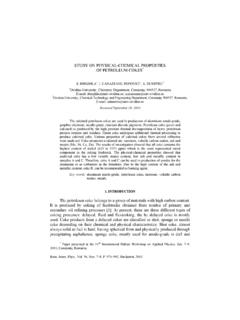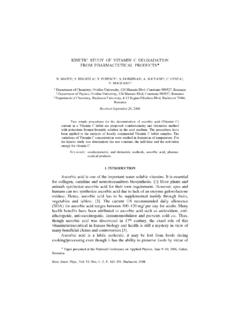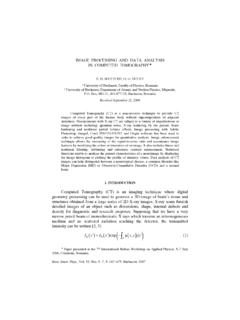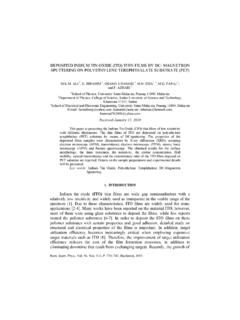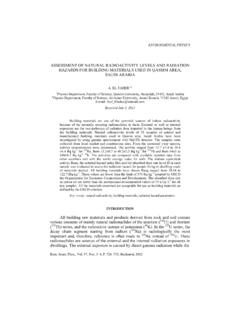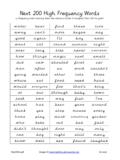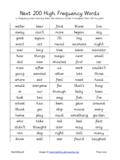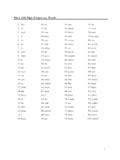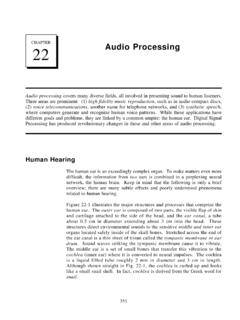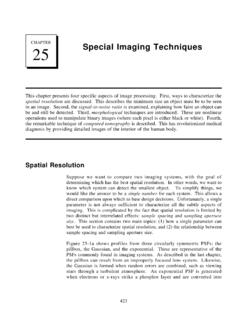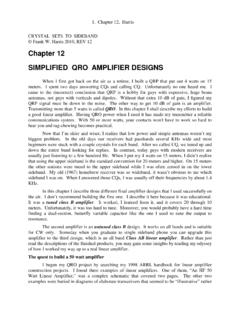Transcription of THE EFFECTS OF HIGH FREQUENCY ELECTROMAGNETIC …
1 THE EFFECTS OF high FREQUENCY ELECTROMAGNETIC WAVES ON THE VEGETAL ORGANISMS* M. URSACHE1, G. MINDRU1, CREANG 1, TUFESCU1, C. GOICEANU2 1 Al. I. Cuza University, Faculty of Physics, 11A Blvd. Carol I, Ia i, Romania, E-mail: 2 Institute of Public Health, 7 A Blvd. Carol I, Iasi, Romania Received September 26, 2007 The influence of radiofrequency (RF) and microwave (MU) ELECTROMAGNETIC waves of non thermal power density upon the assimilatory pigments in the vegetal tissues was studied. Increase in the photosynthetic pigment levels was found in both cases for relatively short exposure times (1 to 4 hours) while for longer exposure time (12 hours), in the plants exposed to microwaves, pigment content diminution was noticed The general increase of the photosynthesis efficiency was presumed to occur in the basis of indirect data provided by the enhanced ratio chlorophyll A/B.
2 Slight stimulatory influence on the biomass accumulation was noticed in the case of MW exposure. Key words: ELECTROMAGNETIC exposure, Zea mays, chlorophyll ratio, biomass accumulation. 1. INTRODUCTION Since atmosphere microwave window allows penetration of cosmic radiation with frequencies ranging within GHz domain, there is always a microwave component within the environment radiation background. In the modern world, with the use of sophisticated microwave emitting devices for communications in the air, surveillance systems, industry, diagnostic and therapeutic purposes in medicine the importance of ELECTROMAGNETIC pollution need not be over emphasized. There is a rich literature describing the biological influence of low FREQUENCY ELECTROMAGNETIC fields upon vegetal organisms. But the responses elicited in various plant species appear to depend in a complex way on both the physical parameters of the irradiation source ( FREQUENCY , power density, pulses or continuous waves, duration of exposure etc.)
3 And the condition of the biological * Paper presented at the 8th International Balkan Workshop on Applied Physics, 5 7 July 2007, Constan a, Romania. Rom. Journ. Phys., Vol. 54, Nos. 1 2, P. 133 145, Bucharest, 2009 M. Ursache et al. 2 134 material magnetic (vegetation stage, pretreatment, environment etc.); nevertheless different biological parameters may lead to the revealing of different aspects of the interaction between the ELECTROMAGNETIC waves and the irradiated material. Some examples are illustrating the above statements. Muraji et al. (1998) reported that an ELECTROMAGNETIC field of low FREQUENCY near 10 Hz has stimulated the growth of corn roots while for higher frequencies above 240 Hz the growth inhibition was noticed [1]. Fischer et al. (2004) have found that 16 Hz ELECTROMAGNETIC field of low intensity (20 microT) caused a small but significant increase in the fresh weight of young plantlets of Helianthus annuus and Triticum aestivum though germination was not influenced [2].
4 Pazur and Scheer (1992) published their findings related to the exposure to Hz and 200 microT ELECTROMAGNETIC field of green algae Chlorella, underlying the inhibitory influence on cell division, while pigment content appeared to be unaffected [3]. Alexander et al. (1995) found that seed germination of onion and rice is accelerated if exposed to a weak ELECTROMAGNETIC field for 12 h and further, the seedlings showed significantly increased fresh and dry weight [4]. Yano et al. (2004) have shown that the main EFFECTS of low FREQUENCY ELECTROMAGNETIC fields (60 Hz FREQUENCY ) on the photosynthetic activity in plant seedlings was consistent with the slightly perturbation of the early growth of the exposed plantlets, by changing the photosynthetic CO2 uptake [5]. It seems that less literature is dedicated to the impact of high FREQUENCY ELECTROMAGNETIC waves upon vegetation since people is interested first of all in the risks of human professional exposure to radiofrequency waves and microwaves as well as in the assessing of the ELECTROMAGNETIC pollution health risks [6 7].
5 However, there are some experimental investigations on living bodies exposed to non-thermal microwaves and radiofrequency waves that focused on plants during early ontogenetic stages when the sensitivity to external constraints is higher as in any other young organisms. The non-thermal effect of microwaves on the germination was reported in [8] on the basis of experiments with cabbage seeds which exhibited delayed germination in contrast with the expectation of stimulated germination related to the well known thermal effect of microwaves. Biological EFFECTS of ELECTROMAGNETIC exposure on different biological parameters of the exposed seedlings were mentioned by Hamada (2007) that reported that under the influence of microwaves, wheat seedlings exhibited decreased ratio chlorophyll a/chlorophyll b, though increased protein accumulation occurred simultaneously [9].
6 Schmutz, P. et al. (1996) reported non-detectable changes in chlorophyll contents following long-term exposure of young spruce and beech trees to 2450-MHz microwave radiation [10]. 3 EFFECTS of ELECTROMAGNETIC waves on the vegetal organisms 135 Some data resulted from our own previous scientific work in the field of bioelectromagnetism have been communicated or published in the last decade. So, the positive influence of microwaves of non-thermal intensity on vegetal tissues at the level of chlorophyll biosynthesis was revealed in the case of two medicinal plant species: Chelidonium majus [11] and Papaver pseudo-orientale [12], while similar data were recorded also in cereal plant species [13 14]. The positive response of cereal plant species Triticum aestivum (wheat) and Secale cereale (rye) at the level of biomass accumulation and length growth following microwave exposure was also noticed [15 16].
7 Some evidences upon the genotoxicity of non-thermal microwaves were reported also by our multidisciplinary research group [17 19]. The biological EFFECTS of radiofrequency waves of non thermal level in plants either grassy or woody were also investigated, the slight photosynthesis stimulation being revealed for chronic exposures of young cereal plants [20] while the inhibition was evidenced in the case of tree seedlings [21]. In the next the authors present comparatively some EFFECTS of radiofrequency waves and microwaves on the plant growth, observable when the irradiation is carried out at low level of power density as in the case of ELECTROMAGNETIC pollution impact on biosphere. 2. MATERIALS AND METHODS BIOLOGICAL MATERIAL Maize (Zea mays L.) grains were selected from single plant genitor in order to assure genophond uniformity: 25 grains in every sample. The plantlet growth was conducted within Angelantoni scientifica microclimate room at 12:12 hours light: dark cycle, at 24 C thermostated environment.
8 Pure distilled water was supplied to the maize plantlets in adequate aliquots all over the experiment. After 14 days, when the nourishing stocks from the initial caryopsides have been finished, the MW exposure and RF waves exposure have been carried out. ELECTROMAGNETIC EXPOSURE The device utilized for the exposure to radiofrequency waves was the transverse ELECTROMAGNETIC cell (TEM) designed to deliver low power density of mW/cm2, at a FREQUENCY of 418 MHz. The TEM device, built in aluminum, has adequate dimensions calculated to assure the characteristic impedance Z0 of 50 . The transverse propagation mode is the dominant one. The vegetal organisms were exposed to the TEM cell for various exposure times (continuous wave exposure): M. Ursache et al. 4 136 1-2-4-12 hours. The microwave generator set-up was designed on the basis of an IMPATT diode. It is able to deliver microwave flow with the power density of about 10 mW/cm2 at the level of its horn antenna at the FREQUENCY of GHz.
9 A probe detector measured the power density of ELECTROMAGNETIC waves flux, which was of about 1 mW/ cm2 (low power density microwaves) in the plan of the plant grains (at the distance of 25 cm from the horn antenna). SPECTRAL ASSAYS Meterteck spectrophotometer type SP 870 Plus; chlorophyll and carotene extracts in 70% ethanol have been assayed on the basis of light extinctions at the wavelengths of 663 nm, 645 nm and 472 nm accordingly to Meyer-Berthenrath s modified method. The calculation formulae are: ()()12 3 663 0 86 EchlAvdw = (1) ()()19 3 645 3 6 = (2) ()10 (3) where: chlA/B = chlorophyll A/B content in mg/g; total carotene content (mg/g); E(l) light extinction to the wavelength l; d cell width (=1cm); v extract volume of ethanol 70% (ml); w tissue weight (g).
10 STATISTICAL ANALYSIS Three repetitions of experimental investigations upon assimilatory pigments were carried out for all experimental variant samples. Average values, standard deviations and t-test have been applied for statistical analysis. The statistic significance of the differences between exposed samples and control ones was assessed by means of the Student t-test. 3. RESULTS AND DISCUSSIONS The experimental data average values and standard deviation are presented in the figures below. 5 EFFECTS of ELECTROMAGNETIC waves on the vegetal organisms 137 RF wave time (hours)Chloriphyll A (mg/g) Fig. 1. a. Chlorophyll A content after plant exposure to RF radiation. RF wave time (hours)Chlorophyll B (mg/g) Fig. 1. b. Chlorophyll B content after plant exposure to RF radiation. As presented in the graphs from Fig. 1 a-b-c, slight stimulation of chlorophylls and carotenes biosynthesis was suggested by the data representing plant response to RF exposure.



